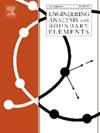A total Lagrangian‒Riemann SPH method with MUSCL reconstruction for large elastic‒plastic deformation and fracture simulation
IF 4.2
2区 工程技术
Q1 ENGINEERING, MULTIDISCIPLINARY
Engineering Analysis with Boundary Elements
Pub Date : 2025-02-01
DOI:10.1016/j.enganabound.2024.106083
引用次数: 0
Abstract
The smooth particle hydrodynamics (SPH) method possesses inherent advantages in simulating large deformations, fractures and crack propagations in solids. However, challenging issues, including tensile instability and numerical oscillations, persist. Total Lagrangian smooth particle hydrodynamics (TLSPH) was proposed to eliminate tensile instability by applying the kernel approximation consistently in the reference configuration; however, the artificial viscosity model has to be added to reduce the numerical oscillation induced by shock and other contact discontinuity simulations, which severely decreases its accuracy and robustness. Motivated by the advantages of both TLSPH and Riemann-SPH of the ULSPH frame, a second-order solid Riemann scheme is constructed on the basis of the Monotone Upwind-Centered Scheme for Conservation Laws (MUSCL) reconstruction and incorporated into the total Lagrangian SPH (TLSPH) framework. The resulting MUSCL-TLSPH method is designed for solving dynamic elastic‒plastic structural impact problems, including large deformations and fractures. This method effectively overcomes the challenges faced by traditional SPH approaches, eliminating the need to introduce artificial stresses related to tunable parameters to maintain computational stability. Finally, the accuracy and robustness of the MUSCL-TLSPH method presented in this paper are verified through a series of numerical validations.
基于MUSCL重构的全lagrange - riemann SPH方法在大弹塑性变形和断裂模拟中的应用
光滑颗粒流体力学(SPH)方法在模拟固体中的大变形、断裂和裂纹扩展方面具有固有的优势。然而,具有挑战性的问题,包括拉伸不稳定性和数值振荡,仍然存在。提出了全拉格朗日光滑粒子流体力学(TLSPH),通过在参考构型中一致地应用核近似来消除拉伸不稳定性;然而,为了减小冲击和其他接触不连续模拟引起的数值振荡,必须加入人工粘度模型,这严重降低了其精度和鲁棒性。基于TLSPH框架和ULSPH框架中的Riemann-SPH的优点,在单调逆风中心守恒律格式(MUSCL)重构的基础上构造了二阶固体Riemann格式,并将其纳入总拉格朗日守恒律框架(TLSPH)。所得到的MUSCL-TLSPH方法设计用于解决动态弹塑性结构冲击问题,包括大变形和断裂。该方法有效地克服了传统SPH方法所面临的挑战,无需引入与可调参数相关的人工应力来保持计算稳定性。最后,通过一系列数值验证,验证了本文提出的MUSCL-TLSPH方法的准确性和鲁棒性。
本文章由计算机程序翻译,如有差异,请以英文原文为准。
求助全文
约1分钟内获得全文
求助全文
来源期刊

Engineering Analysis with Boundary Elements
工程技术-工程:综合
CiteScore
5.50
自引率
18.20%
发文量
368
审稿时长
56 days
期刊介绍:
This journal is specifically dedicated to the dissemination of the latest developments of new engineering analysis techniques using boundary elements and other mesh reduction methods.
Boundary element (BEM) and mesh reduction methods (MRM) are very active areas of research with the techniques being applied to solve increasingly complex problems. The journal stresses the importance of these applications as well as their computational aspects, reliability and robustness.
The main criteria for publication will be the originality of the work being reported, its potential usefulness and applications of the methods to new fields.
In addition to regular issues, the journal publishes a series of special issues dealing with specific areas of current research.
The journal has, for many years, provided a channel of communication between academics and industrial researchers working in mesh reduction methods
Fields Covered:
• Boundary Element Methods (BEM)
• Mesh Reduction Methods (MRM)
• Meshless Methods
• Integral Equations
• Applications of BEM/MRM in Engineering
• Numerical Methods related to BEM/MRM
• Computational Techniques
• Combination of Different Methods
• Advanced Formulations.
 求助内容:
求助内容: 应助结果提醒方式:
应助结果提醒方式:


